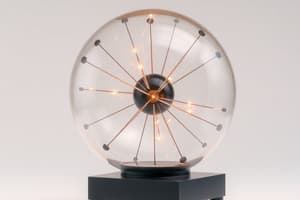Podcast
Questions and Answers
What is the formula for work done by a force acting on an object?
What is the formula for work done by a force acting on an object?
- W = Fd (correct)
- W = s/t
- W = Q
- W = ma
In mechanical engineering, how is the work done by a lever in lifting a load calculated?
In mechanical engineering, how is the work done by a lever in lifting a load calculated?
- W = Fdcosθ (correct)
- W = Fd^2
- W = Fd + θ
- W = d/θ
Which field uses work calculation to determine the work done by forces acting on structures like bridges and dams?
Which field uses work calculation to determine the work done by forces acting on structures like bridges and dams?
- Civil Engineering (correct)
- Chemistry
- Electrical Engineering
- Physics
What does 'd' represent in the work formula W = Fd?
What does 'd' represent in the work formula W = Fd?
In work calculation, what does 'θ' represent when calculating the work done by a lever?
In work calculation, what does 'θ' represent when calculating the work done by a lever?
The work done by the wind on a bridge can be calculated using which formula?
The work done by the wind on a bridge can be calculated using which formula?
What is the formula for calculating the work done by an electric field on a charged particle?
What is the formula for calculating the work done by an electric field on a charged particle?
Which of the following is NOT an application of work calculation in engineering and physics?
Which of the following is NOT an application of work calculation in engineering and physics?
In the context of work calculation, what does the symbol 'q' represent?
In the context of work calculation, what does the symbol 'q' represent?
What is the purpose of work calculation in the design of machines?
What is the purpose of work calculation in the design of machines?
Which of the following is NOT mentioned as an application of work calculation in the given text?
Which of the following is NOT mentioned as an application of work calculation in the given text?
What is the significance of work calculation in structural analysis?
What is the significance of work calculation in structural analysis?
Flashcards are hidden until you start studying
Study Notes
Overview of Work Calculation
Work calculation refers to determining the work done by a force or system of forces in performing a task or moving an object. It is a fundamental concept in physics and engineering, used in various fields such as mechanical engineering, electrical engineering, and civil engineering.
Key Concepts in Work Calculation
Work Formula
The work done by a force acting on an object is given by the formula:
W = Fd,
where W is the work, F is the force, and d is the distance over which the force acts.
Work Calculation in Mechanical Engineering and Civil Engineering
In mechanical engineering, work calculation is used to determine the work done by a machine or a system of machines in performing a task or lifting an object. For example, the work done by a lever in lifting a load can be calculated using the formula:
W = Fdcosθ,
where F is the force applied to the lever, d is the distance over which the force acts, and θ is the angle between the force and the direction of the motion.
In civil engineering, work calculation is used to determine the work done by forces acting on structures such as bridges, buildings, and dams. For example, the work done by the wind on a bridge can be calculated using the formula:
W = Fd,
where F is the force of the wind, and d is the distance over which the force acts.
Work Calculation in Electrical Engineering
In electrical engineering, work calculation is used to determine the work done by an electric field on a charged particle or by a magnetic field on a current-carrying wire. For example, the work done by an electric field on a charged particle can be calculated using the formula:
W = qV,
where q is the charge of the particle and V is the electric potential difference across the field.
Applications of Work Calculation
Work calculation has many applications in engineering and physics, including:
- Design of Machines: Work calculation is used to determine the force and distance required to perform a task, which helps in designing machines that can perform the task efficiently.
- Energy Analysis: Work calculation is used to determine the energy stored or released in a system, which helps in analyzing the energy balance in a system.
- Structural Analysis: Work calculation is used to determine the forces acting on structures such as bridges, buildings, and dams, which helps in analyzing their stability and safety.
- Circuits and Electromagnetism: Work calculation is used to analyze circuits and electromagnetic systems, such as electric motors and generators.
Conclusion
Work calculation is a crucial concept in engineering and physics, used to determine the work done by forces in performing tasks or moving objects. Understanding work calculation helps engineers design machines, analyze energy systems, and ensure the safety and efficiency of structures.
Studying That Suits You
Use AI to generate personalized quizzes and flashcards to suit your learning preferences.




